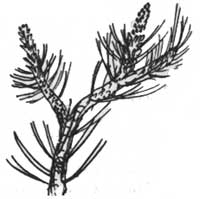

|
By Ranger Naturalist A. Russell Croft THE PINE is one of the few trees which may have the fruit crops of two successive years developing on the same tree at the same time. Consequently, it is possible at this time, July 1, 1932, to determine the size of the 1932 fruit crop, and also to estimate the approximate size of the 1933 crop - about fifteen months before the latter crop of so-called "nuts" is mature. The "nut" of the pine is not a nut at all, but a true seed. In this very brief discussion the term seed will be used. The seed crop of the Pinyon Pine, Pinus edulis, on the South Rim of Grand Canyon will in all probability be considerably below normal in 1933. Before giving the reasons for this belief it seems advisable to explain how the seeds of the pine originate and grow to maturity. The process is fundamentally the same for all pines, but this statement is made with special reference to the Pinyon Pine. Pines bear two kinds of flowers, commonly called cones. The male flowers, born in lateral clusters, principally on the lower two-thirds of the tree, produce pollen. Their function is completed as soon as the pollen is mature. The female flowers are small cone-like structures born terminally, principally on the upper third of the tree. They contain the embryonic seeds and normally remain on the tree until mature, developing into the fruit. Two naked seeds are usually produced on the upper surface of each scale of the fruit (cone). Under favorable conditions a tree with a developing crop of year old fruit will often bear a crop of female flowers or cones which, at least for one summer, will undergo their early development along with the year old fruits. Thus, two fruit crops may be found on a single tree at the same time so it is possible to estimate the fruit crop for two consecutive years. The Pinyon exhibits another interesting phenomenon in connection with flower bearing which is possibly true, more or less, of all pines. In the spring the vegetative buds elongate into branches with the embryonic leaves spaced proportionately along them. Then, almost simultaneously, two buds appear on the end of this new branch. They are, (1) the vegetative bud with its embryonic stem and leaves for the following year's growth, and (2) the female flower bud. This latter bud develops immediately into the female flower and differs also from its companion bud in that its primordia existed in the parent bud from which the new stem grew. Thus, nature makes two important steps which insure future growth before expending the energy necessary for the production of leaves on the current stem growth. (See sketch). 
As has been stated previously, the female flowers appear on the upper third of the tree, especially near the top, and consequently are not easily detected with the unaided eye when they first appear. However, with a good binocular the tree tops may be easily examined for the presence of the flowers. In estimating the fruit crop for any given year a standard by which to make a comparison must be selected. In estimating the 1933 crop, the only tangible basis of comparison is the 1932 crop now on the trees. The estimate has been based on the following observations: 1. A scarcity of fruit on the young trees of bearing age. 2. A scarcity of fruit on trees now maturing a fruit crop. 3. A scarcity of fruit on the mature trees which will not bear fruit in the fall of 1932. The 1933 fruit crop, estimated on the basis of the number of female flowers at the present time, will be reduced considerably before maturity by the following factors: 1. Failure to pollenate. 2. Failure to fertilize. 3. Mechanical injuries due to storms. 4. Consumption for food by animals. 5. Natural thinning. 6. Unknown causes. In certain localities around Grand Canyon, notably at Hermit's Rest, a very good crop of seeds will be produced in 1933. Also, along highways where drainage from higher ground has provided a greater supply of soil moisture, a very favorable crop of seeds will probably be produced, but in general the crop will be considerably below normal, as already stated.
| ||||||
| <<< Previous | > Cover < | Next >>> |
vol7-6e.htm
14-Oct-2011